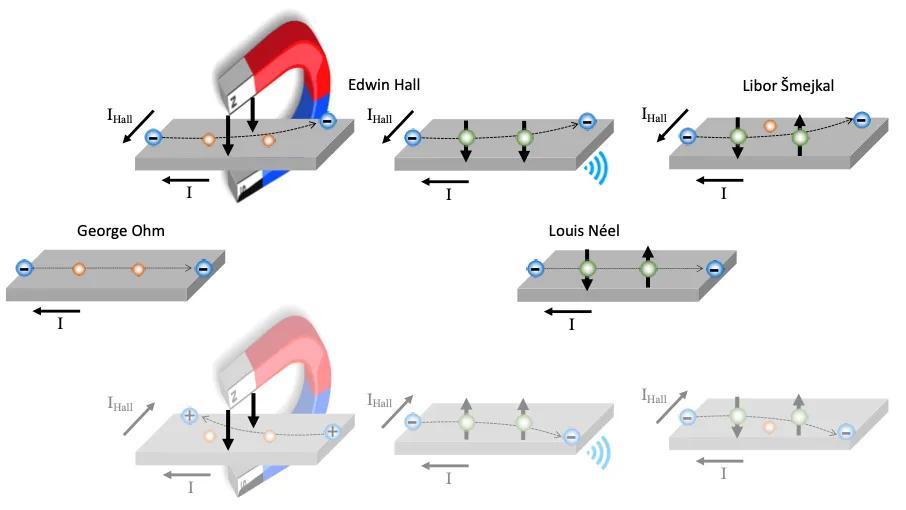In a paper published in Science Advances1, Libor Šmejkal with his colleagues from the Institute of Physics of the Czech Academy of Sciences in Prague reports the discovery of a Hall effect in an antiferromagnet. It is another extraordinary work by an exceptional Czech talent who as a fresh PhD graduate already enjoys the reputation of an internationally leading figure in his field.
To explain the groundbreaking nature of the work, let us first recall in a nutshell the prior physics inherited from Ohm, Hall and Néel. In common non-magnetic conductors like copper, the applied and observed current directions are the same, obeying the Ohm’s low.
In the presence of an external magnetic field, however, the current bends away from the applied direction, resulting in an additional transverse component called the Hall current. Since its sign depends on the sign of the charge particles carrying the current, it allowed for the discovery of n-type and p-type semiconductors with negative electron and positive hole carriers, a notion that underpins modern microelectronics.
Hall’s second discovery was that an internal magnetization of a ferromagnetic conductor like iron can also cause the transverse current deflection. And like in the case of the external magnetic field, flipping the north and south poles of the internal magnetization reverses the sign of the Hall current. This made the Hall effect also one of the cornerstones of magneto-electronics, a broad field ranging from sensor to memory technologies.
Ferromagnetism, however, is not the only type of magnetic order in nature. Louis Néel, credited for the discovery of the second family of so called antiferromagnets, left us with a legacy of mixed feelings about these magnets whose north and south poles periodically switch places when moving from one to the neighboring magnetic atom in the crystal.
On the positive side, they are much more abundant in nature than ferromagnets. On the down side, however, it seemed inevitable that the oppositely oriented atomic magnets cancel the effects observable in ferromagnets, including the Hall current. The remaining ordinary Ohm’s current then makes antiferromagnets indistinguishable from the common non-magnetic conductors and inapplicable for magneto-electronics.
Libor Šmějkal’s discovery breaks with this conventional scientific wisdom. He takes a crystal comprising the antiferromagnetic atoms. On their own, they would generate no Hall current, in agreement with Néel. Then he adds non-magnetic atoms in the crystal. Again, on their own, these atoms would only allow for the ordinary Ohm’s current. However, with a suitable combination of both the antiferromagnetic and non-magnetic atoms present in the crystal, the Hall effect arises. It is a striking example of the ancient “the whole is greater than the sum of its parts” or, in modern terminology, of synergy. Remarkably, crystals comprising the suitable arrangement of antiferromagnetic and non-magnetic atoms are not a mere theory construct or a rarity in nature. Néel himself made his seminal works on rutile antiferromagnets which have precisely this type of crystal structure and are very common.
The discovery has a special place in the rapidly growing new field of antiferromagnetic magneto-electronics (spintronics) pioneered by the researchers from the Institute of Physics in Prague. While other branches explore and exploit the insensitivity of antiferromagnets to disturbing magnetic fields, the extremely fast response to electrical and optical stimuli, or multi-domain neuromorphic device characteristics, the antiferromagnetic Hall effect opens the prospect of low-dissipation electronics.
The prospect is particularly appealing in the context of the alarming recent trend of information technologies becoming the leading industry sector in energy consumption. The discovery has also the potential to revert the growing demand in conventional magneto-electronics for rare heavy elements and, instead, directs the research and applications towards abundant materials.
Breaking with the conventional scientific wisdom requires extraordinary talents and skills. Libor Šmejkal has defended his PhD thesis a few months ago with a track record of a dozen of invited talks at international conferences, a dozen of papers including four in Nature/Science family journals and two in Physical Review Letters, two papers listed as Highly Cited on Web of Science, and the total number of citations according to Google Scholar exceeding 500.
Immediately after the PhD defense, Libor Šmejkal was offered and took the position of an independent team leader at the Johannes Gutenberg University of Mainz in Germany. A positive message for Czech science is that, besides building an international research network, the position allows him to keep his former close collaboration links with the Institute of Physics in Prague.
Contacts:
Libor Šmejkal, smejkall [at] fzu [dot] cz (smejkall[at]fzu[dot]cz)
Tomas Jungwirth, jungw [at] fzu [dot] cz (jungw[at]fzu[dot]cz)
Department of Spintronics and Nanoelectronics
Institute of Physics of the Czech Academy of Sciences
1 Libor Šmejkal, Rafael González-Hernández, Tomáš Jungwirth, Jairo Sinova, Crystal time-reversal symmetry breaking and spontaneous Hall effect in collinear antiferromagnets, Science Advances 6 (2020) eaaz8809
